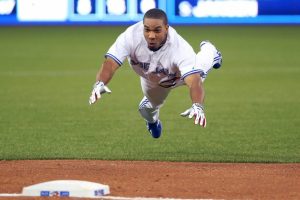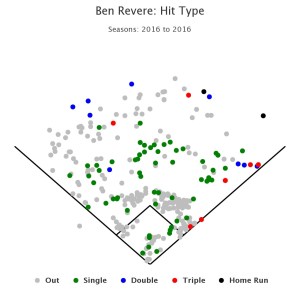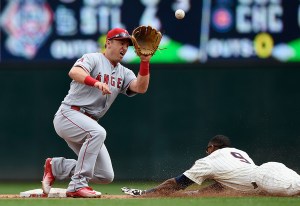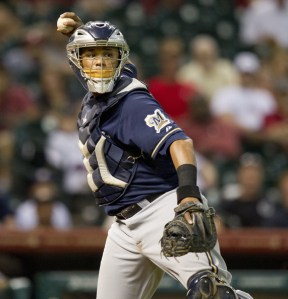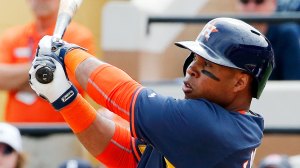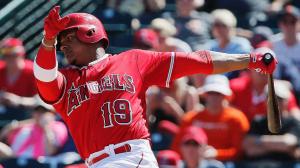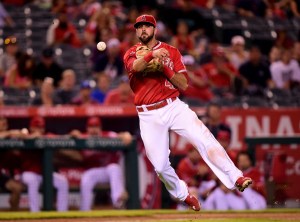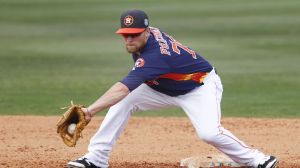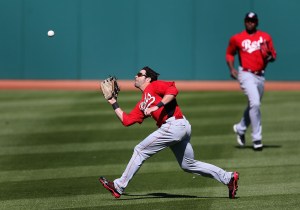Author’s Note: If you missed the previous installments you can find Part I here, Part II here, Part III here, Part IV here, Part V here, Part VI here, Part VII here, Part VIII here, Part IX here, Part X here, Part XI here, Part XII here, and Part XIII here.
We have spent a lot of time in this Primer Series talking about the full time members of the team but Billy Eppler has also spent a lot of time and a not insignificant amount of resources on our next topic of discussion, the bench.
The following players are currently on the Angels 40-man roster and are available for bench or, if necessary, even full time roles at any time in 2017:
|
|
Also the following players spent time in the Minors last year for the Halos AA and AAA affiliates or were acquired in the off-season and could be called up later in the year as injury reserve bench replacements:
|
|
To be clear these players are not on the 40-man roster making them remote options only to be used in case of multiple injuries to top players on the depth chart at any particular position.
First of all it is pretty distinct at this point whom the Angels will have on their bench to start off 2017.
Typically the Angels begin every season with eight relievers because the starting rotation is not stretched out to their full capability in terms of innings pitched per game. However the Angels currently have three players, Maldonado, Revere, and Pennington signed to Major League deals which means, barring a trade, severe under-performance or pre-season injury, the team will almost certainly carry a three man bench and eight relievers to begin 2017.
For the purposes of this article we will touch only on the 40-man roster players plus one of my personal favorites, Sherman Johnson, who seems primed to get his first taste in the Majors starting in 2017.
Ben Revere
Some things Billy Eppler has done well this off-season is identifying opportunities to improve the team, striking decisively in a manner that stays within the confines of team payroll limits, and not dealing away any of our remaining significant assets from the Minor League farm system.
Ben Revere, just like Maybin at the beginning of the off-season, is a good example of this approach.
Eppler signed Revere to a 1-year, $4M deal with incentives that can raise it up to as high as $6.5M total. The incentives are tied to how many plate appearances Ben makes in 2017 and are broken out in steps over three different tiers with an extra $125K at 300, 325, and 350 PA’s, $175K at 375 and 400 PA’s, and $225K at 475, 500, 525, and 575 PA’s.
The contract is structured in this way for a few reasons: 1) if Revere proves to be a capable backup outfielder and pinch hitter he wanted to be rewarded for that effort, 2) if the Angels are out of the playoff hunt in mid-July and Ben is performing he wants to be potentially rewarded wherever the Angels ship him off too in trade and 3) if he is not performing and the Angels are out of the playoff race, he will, in theory, take over left field duties from Maybin who would probably be dealt in trade himself at the deadline.
Revere fits the type of hitter that Billy Eppler has been accumulating and provides insurance in the lead-off spot if Cameron is injured or does not perform. Additionally if Calhoun gets hurt, Maybin could slide over to RF and Revere can back-fill LF.
Ben had a down year last season playing for the Nationals and you can see that his batting average on balls in play (BABIP) was significantly lower (.234) that his career average (.314). There are explanations for this deviation.
One is that he hit about 8-9% more fly balls, in 2016, as compared to his career average. Also against right-handed pitchers he hit 4.5% less line drives. As we will discuss in an upcoming section of the Primer series this reduction in line drives and increase in fly balls had a detrimental impact to his BABIP.
However that increase in fly balls cannot account for all of his woes. Bad luck almost certainly played a large part in his depressed numbers because if you look at his FanGraphs spray chart for last year you can see that he clustered a lot of his hits all around the diamond, particularly to 2B:
As you can see there was very little dispersion which simply means that someone like Ben with a long history of excellent batting average and singles probably just had some bad luck in hitting the ball right into the opponent’s defense.
Revere’s contact numbers all remained steady so if he can fix some of the fly ball issues that crept into swing mechanics and just get more lucky in getting singles and doubles past the infield you should see, at the minimum, an improved season from Ben and possibly a complete return to form if he can recapture his career line drive percentage against right-handed pitchers.
Ben will probably be called upon quite often as a pinch hitter and runner in late innings to replace hitters like Pujols and Cron (Valbuena now probably) who can clog up the bases. Scioscia loves this type of hitter and runner off of his bench and Revere has a long history as a premier base stealer with 38 stolen bases vs. LHP (69% success rate) and a whopping 152 stolen bases vs. RHP (83% success rate).
Finally Revere provides good defense in the corners and average defense in center field. He really is a quintessential 4th outfielder who has enough utility and speed to make him really useful as an injury reserve and will give you a really great at-bat because he puts the ball in play which is what you want out of a pinch hitter.
Great pickup, low risk move, by Eppler, this will likely go down as a really savvy depth move for the team.
Cliff Pennington
Next on our most likely list, barring a preseason trade, is utility infielder Cliff Pennington, who is in the last year of an affordable 2 year, $3.75M contract.
Cliff was brought on board to provide a veteran utility option with strong defensive skills. He can play any infield position well and can even play left field in a pinch with ease. Pennington is the prototypical defensive backup utility player who can enter the late stages of a game as a defensive replacement in a close contest.
Pennington has never been a rock star with the bat. He owns a career .243/.310/.342 slash line which, for a utility infielder, is fairly good. It is really his glove and range as a defender that brought him to the Angels in the first place. Cliff has a career wRC+ of 86 vs. RHP and 62 vs. LHP. That skill set is enough to carve out a career in Major League Baseball.
The Angels have been accumulating future utility players to replace Pennington either preseason, at the deadline, or at season’s end. Moving forward all three of Kaleb Cowart, Nolan Fontana, and Sherman Johnson will have an opportunity to win this position, if not a regular full-time one, by, at the latest, next season. One or two of them could even be possible trade candidates.
Pennington will likely start the season as the primary middle infield utility player primarily due to his Major League contractual obligation.
Martin Maldonado
In the introduction to the Primer Series, here, it was the author’s opinion that the Angels needed to sign or trade for a veteran catcher and either trade one of our current catchers, Perez or Bandy, or simply start Jett, who had options, down in the Minors to start the season. Ultimately the Angels, a bit surprisingly, dealt Bandy rather than Carlos, to the Brewers for veteran catcher Martin Maldonado and RHP Drew Gagnon.
Famed statistician Bill James recently called Martin Maldonado the “…. Best .217 hitter in baseball.” This was not sarcasm (maybe a little about his average) as it genuinely seems Bill was enamored enough with the rest of Martin’s skill set that he almost included him in his Top 10 list of catchers for 2017.
So what did Billy Eppler (and Bill James) see in Maldonado that makes him valuable to the Angels?
First of all Martin is widely viewed as a good pitch framer. Per StatCorner, he has consistently ranked in the Top 20 pitch framers for the last five years which is clearly a skill that Eppler values and believes in.
For those of you who may not be familiar with pitch framing, the basic premise is that any pitch border line on the strike zone may be called a ball or strike by the umpire. A good pitch framer will convert more of those pitches that should be called balls into called strikes.
Basically the Angels traded up Bandy, who saved one run in the aggregate in 2016 with his pitch framing, for Maldonado, who saved 7 runs over the course of the season. The standard is that approximately 10 runs equals 1 win so the Angels probably feel that they improved marginally in this department.
Martin can, like Perez, control the running game. He has a career 35% caught stealing rate and moves well behind the plate which will almost certainly please Mike Scioscia. FanGraphs defensive rating (DEF) has consistently rated him high over the last five seasons as well.
Not only did Eppler select Maldonado for his defensive prowess but also for his ability to hit left-handed pitching. Martin, over a 3-year running average, owns a wRC+ of 95 vs. LHP. This, along with his other skills, makes him a great platoon partner for a catcher that can hit right-handed hitters better than Maldonado’s poor 3-year average of a 62 wRC+ vs. RHP.
Also more importantly Maldonado’s walk rate has been steadily increasing each year from 6.4% BB% in 2013 to last year’s impressive 13.8% BB%. On top of that his strikeout rate decreased in 2016 to 22.1%, nearly 2% below his career rate. The latter could be a blip on the radar though so we should not read too much into it at the moment but the walk rate seems at least somewhat sustainable based on the trend.
Basically the Angels lost the years of control of Bandy for two years of Maldonado’s pitch framing, his sustainable success against LHP, and his ability to take a walk. In addition to all of this Eppler picked up RHP Drew Gagnon, whom he appears to be enamored with so we will likely know the full breadth and value of this trade at a later date and time.
Luis Valbuena
This Primer article was going to be delivered for publication last week and then word arrived that the Angels were on the verge of signing Luis Valbuena so I patiently waited for the Angels to announce the signing to include him here.
Initially it was believed that Luis would be a platoon partner for 3B Yunel Escobar or possibly even 2B Danny Espinosa but soon after the signing Billy Eppler has stated that Valbuena will pick up at-bats at 1B.
If you have been following the Primer series the latter will actually not be that surprising because we discussed the possibility that the Angels might explore trade opportunities to move C.J. Cron in Part VI. Luis clearly has a very similar offensive production to Cron as seen below:
Valbuena’s career numbers have been depressed mostly due to his part-time usage across his Major League career. The interesting data points from this table are his significant increases in offensive production mostly against right-handed pitching. He has actually performed better than C.J. over the last three years against them (wRC+ of 126 vs. wRC+ of 119).
Below is Luis’ batted ball profile:
The lower exit velocity in 2016 may simply be an outlier due to Valbuena’s injury-shortened season. Beyond that you can see his hard contact against right-handed hitters has significantly improved over the last two years as well as his line drive rate and HR/FB ratios.
One other important takeaway is Luis’ extreme pull tendencies particularly against right-handed pitchers. Luckily he is lifting the ball more but this could prove problematic if teams figure out a way to implement a shift against him but this remains to be seen.
On defense Luis has greater utility position-wise than C.J. with his ability to play the corner infield spots and, if needed, at the keystone. This will improve overall team depth and allow the Angels to better deal with possible injuries to Simmons, Escobar, or Espinosa. There is a real possibility that he will play above average defense at 1B which will help fulfill Eppler’s dream of having a good defender at every position.
As Dave Cameron of FanGraphs noted here, the Valbuena signing represents a less expensive way to achieve similar production to a slugger like Mark Trumbo. Eppler was able to replicate C.J.’s production and this now allows Billy to create competition at the spot, trade Cron, or build really good depth by exercising C.J.’s final option to have him start the year in Salt Lake.
Also, next year, Eppler will have options to use Luis to fill the 3B or 2B openings once Escobar’s and Espinosa’s contracts have expired. Alternatively he can simply keep him at 1B too which is the likeliest outcome.
This is a solid two year signing and there is even a mutual option, so there is very little risk here and quite a bit of upside value. Good signing by the team.
Jefry Marte
Perhaps one of the more underrated Angels last season, Jefry Marte put in a really strong performance over 284 plate appearances in 2016.
First of all Marte put in some good defensive effort over 537 innings of work spread out pretty evenly between 1B, 3B, and LF according to FanGraphs DEF metric. This is a small sample size and it should be taken with a grain of salt, particularly since noted prospect analysts such as John Sickels are not a huge fan of his defensive work in the Minors. However, based on Marte’s relatively young age, there is still room for improvement in his game and he may still reach the potential he had when he was first drafted.
The Angels did see hints of that potential not only defensively but offensively as well. First let us look at Jefry’s batted ball profile:
Marte has a limited history of at-bats in the Majors so these numbers may not tell the full story but the one thing that does leap off the page is how much of a pull hitter he is, particularly against right-handed pitching.
This may just be a side effect of his short time in the Majors but it is something to keep an eye on moving forward. If he continues to be such a strong pull hitter opposing teams will eventually begin implementing a defensive shift against Jefry. This could potentially depress his average further and cast doubt on his ability to be a full-time regular, possibly relegating him to a corner infielder bench role.
One other important detail is Marte’s 2.6 mph increase in exit velocity from 2015 to 2016. Power is one of Jefry’s calling cards and the increase in exit velocity bodes well for his isolated power if he can maintain, or even improve, as his career progresses.
Because of his high ground and fly ball tendencies, to date, Jefry will likely run lower than average BABIP’s in the .260-.280 range. It is of course possible that his line drive percentage will improve but because of his immense power the Angels probably want him to focus on having big at-bats and keeping more loft in his swing to allow his strength to drive the ball (not dissimilar to what Pujols has done since he arrived with the Angels).
Below is a snapshot of Jefry’s platoon splits over his short career:
In Marte’s limited time in the Majors he has been remarkably productive, despite the mediocre batting average and on-base percentage. Again, as indicated above, Jefry’s power and ability to crush the ball has allowed him to post a 98 wRC+ vs. RHP and 129 wRC+ vs. LHP. Over the last two years only Mike Trout has hit more extra base hits on a per plate appearance basis than Marte for the Angels.
During Jefry’s Minor League career he carried mid-teens strikeout percentages so there is potential for him to crest the sub-20% line in future seasons which would aid, albeit slightly, his on-base percentage and BABIP numbers.
Marte is unlikely, based on his early batted ball profile, to run high batting averages, likely staying in the .230-.260 range. He is a brute force hitter and can likely carve out a niche career either in a full or part-time role because of it. His early offensive and, to a lesser degree, defensive profile is not dissimilar from the Cardinals Jedd Gyorko if you are looking for a comparable.
Jefry is, at this moment, a good role player, corner utility player, and bat off of the bench for the Angels. He is very likely going to start the season in AAA to get regular at-bats, playing the corner infield, and possibly corner outfield, positions, in preparation for an eventual call-up in either late May/early June or after the trade deadline.
There may be more if Marte can further tap into his potential so 2017 will be a critical year in his development and his future with the Angels.
Kaleb Cowart
Speaking of tapping into their potential, Kaleb Cowart, too, has a critical year ahead of him in 2017.
The former 2010 first round pick (18th overall) has certainly had his share of struggles climbing up the rungs of the Minor League ladder. He probably would love to forget about his dismal 2013, 2014, and first half of his 2015 seasons, they were pretty poor offensively and put him on the bubble of being a bust.
However Cowart, in the 2nd half of 2015, rediscovered some of his previous offensive success and is now back in the conversation at 3B as well as a possible, future utility player due to his solid defense across multiple positions.
In a limited sample size for 2015 and 2016, Kaleb showed well at 3B per FanGraphs Ultimate Zone Rating per 150 games (7.3 and 3.1 respectively). Playing 2B, in an even more limited sample size of innings played, he showed well at the keystone per the same metric as well (21.6). All of this should be taken with a big grain of salt but there is some truth to his defensive potential at 2B, 3B, and even SS. Good defense can help any player carve out a career in the Majors.
To get a better feel for where Cowart is at offensively let us start by taking a look at his batted ball profile:
Now to be clear the sample size here is quite small, only 139 plate appearances split 40/60 between 2015 and 2016 respectively. There is not a lot we can draw from this but there are a couple of interesting items that should be watched moving forward.
One is the observed 87 mph exit velocity in 2016. There are no other data points to compare it too but if his true talent level is close to that he would be in high company with hitters such as George Springer and Carlos Correa. Again 2017 will be an important comparable to this number. Sample size could also be introducing a lot of noise to this metric.
The other item that may mean something for Cowart’s future is the relatively good all-fields approach, particularly up-the-middle. Again sample size here is really small but a good approach at the plate can lead to better results.
To complete the limited picture his numbers are trying to paint let us look at the remainder of Kaleb’s offensive profile:
This table too offers little to the conversation (sample size matters!). It is really hard to extract much of value here. In Kaleb’s Minor League starts over the same period he did much better, particularly against RHP but those of course are not Major League plate appearances. We really need to see more consistent playing time in Anaheim to get a better feel for his floor.
Fortunately Cowart still has time to work these issues out. He will be 25 years old in early June and he is already breaching the Majors so he still has time to straighten out the kinks in his game and discover what he can truly be.
Just like Jefry Marte, 2017 will be a critical year for Kaleb to show what he can do. He is likely to start the season in the Minors but there should be opportunities for him to hitchhike on the shuttle from Salt Lake to Anaheim. Kaleb’s defensive ability will find him a spot on the 40-man but it his bat that will decide how often he is on the 25-man.
If the Angels struggle and are out of the playoff race by the end of July, there could be a real opportunity for Cowart to get full playing time at either 3B or 2B, so he needs to be prepared for whatever the year holds.
There is a real possibility that Kaleb could wind up being one of those “change of scenery” guys and gets traded at some point in the near future, particularly if his bat does not play up and Eppler decides that the team needs a utility bat that can handle left-handed more than right-handed pitching. Time is still on Cowart’s side though.
Nolan Fontana
Fontana, recently acquired via waivers from the Houston Astros, is known for his above average defense and on-base ability as well as, in the words of Sickels, a “spectacular feel for the game.”
Over the last three seasons, in aggregate, Nolan has fairly even platoon splits with an excellent batting eye. He suffered from BABIP issues in 2016 but overall he is above average at putting the ball in play.
Eppler brought Fontana in to compete with Kaleb Cowart and Sherman Johnson for the utility role once Cliff Pennington is traded or his contract expires (he is a free agent after 2017).
Nolan may have a hidden advantage over the other two in terms of defensive positional versatility and in his fairly even splits because both Johnson and Cowart have shown a propensity to hit right-handed pitching much better than they do lefties. Also Cowart and Johnson may not be quite as good at shortstop as Nolan.
Fontana simply provides one more potential solution to the utility discussion and he will almost certainly start the year in the Minors to continue his development. If the Angels are out of the Division race in mid-Summer Nolan could get a call up if he is executing well in the 1st half.
Ryan LaMarre
In late November of last year, Billy Eppler took one of his first steps in building depth for the 2017 Halos by signing utility OF Ryan LaMarre to a one year Major League deal.
First and foremost LaMarre is a defensive specialist. He came up in the Reds organization and for four years in a row, from 2011-2014, he was named Baseball America’s best defensive outfielder for their organization.
Sickels also likes his defense, physical tools, and above average speed. John noted in the article that there is also some streaky pop in LaMarre’s bat.
Ryan had a solid 2016 for the Red Sox AAA affiliate and so Eppler decided to acquire him to add a quality defensive player who has some possible upside in his offensive profile that could play in the Majors.
In the end LaMarre should provide very capable defense in a 4th/5th OF role as a quality depth piece for short periods of time if needed. It was smart for Eppler to sign him out of the Minor Leagues on a Major League deal to secure his services from other suitors.
Sherman Johnson
Although Sherman is not officially on the 40-man roster he is a Minor League player that could potentially impact the Angels 2017 season.
Johnson is a solid middle infielder who can play an adequate shortstop but is probably best defensively at the keystone or hot corner where he excels and provides more value.
Sherman has been frequently highlighted in Carson Cistulli’s FanGraphs ‘Fringe Five’ weekly season series over the last couple of years which highlights prospects that are not on Top 100 prospect lists but show favorable traits and abilities. Last season Sherman rated as the most mentioned player in the series so you should check it out (also Cistulli’s articles are a blast to read).
Offensively Johnson has consistently posted a high quality on-base percentage throughout his Minor League career (.364 OBP). In the last three seasons he has had greater success against right-handed pitchers over left-handed ones but that might be more BABIP (bad luck) related so there may be some smoke and mirrors here regarding his splits.
Sherman also has solid base running skills and over the last 3 years has stolen 64 bases in 83 attempts good for an above average 77% success rate.
Johnson’s floor is likely a utility guy with the upside of a regular MLB player if can maintain and transfer his current levels of production to the Majors. Look for Sherman to get his first opportunity in Anaheim sometime later this year. In the meantime he will probably start the year in Salt Lake, working hard and waiting for his opportunity to make the leap.
Add The Sports Daily to your Google News Feed!

